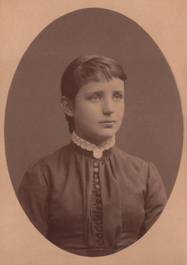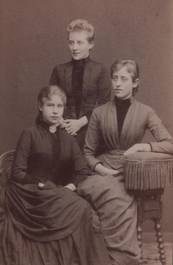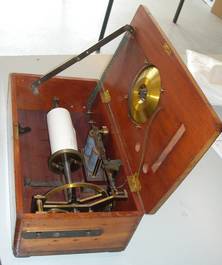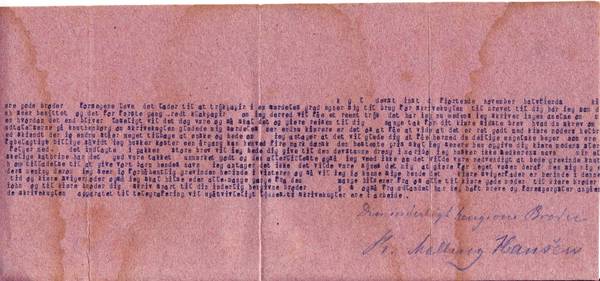1870.11.14 English
r o y a l instit f the deaf a dumb nov fourteen seventy[1]
my dear brother[2] the trials are ongoing it seems that printing paper[3] is particularly suitable for the writing ball for this letter for you i have as you will see for the first time used red paper[4] whether or not i will get a neat print i have at the moment no idea[5] but whatever the case it will be legible and it will also travel to you thank you so much for your last dear letter what you wrote concerning the comments from knuthenborg about the writing ball pleased me very much but i am even more happy to learn that dear mother’s health is fairly good although we would wish and pray for it to be even much better i think you will be very pleased to receive these lovely english books that are fabulously cheap as far as i remember one annual volume is merely four danish marks i will later let you know the exact price dear mother’s veil is also enclosed. The large letter included in the parcel[6] i will ask you to give to the deaf-mute boy in maribo i do not remember the name of the carpenter my beloved kathrine and the tiniest[7] of the toddlers are both very well thank god i do not know whether it would be necessary to ask countess knuth for her permission to give our daughter her name i suppose not it seems to me that it would be to make too much of a fuzz about it but please tell me what you think about it i expect i will meet the countess in copenhagen sometime this winter and then i could of course tell her dear father-in-law is here at the moment and dear mother-in-law as well i have greetings from all of them for you fondest greetings from all of us for dear sweet mother and for dear brother iohn and to you dear brother please write soon again to your deeply devoted brother i have had letters and requests about the writing ball even from abroad the machine for telegraphy will undoubtedly succeed. ten writing balls are being manufactured[8].
Your deeply devoted brother
R Malling Hansen
[1] CB: This is – status of 31 July 2007 – only the fourth letter, typed on the writing ball, that we know of – and only the second of which we have a copy. The format is – just like the first letter we know of – very unusual in that it is typed with the paper lying “on the side” in relation to normal scripture, giving more than 100 strokes per line. See the matching photo. The letter was typed on the very first version of the writing ball, which featured only lower case letters – and the paper was wrapped around a cylinder, mounted in a box. Considering that, it is actually amazing how few typing errors there are (JMC/translator’s comment: the letter has three typing errors – possibly one or two more – but I have chosen not to introduce any deliberate typing errors in the English version. I am using the hyphen ‘-‘ in the translation, but that character was not available to RMH on this version of the writing ball)
[2] CB: RMH had two brothers, but almost all the letters we know of were written to the middle brother Jørgen. As shown by the text, Jørgen – who himself was a teacher and working close by RMH’s childhood home where also his mother was staying. This was also close to the Knuthenborg Estate, whose proprietor paid for RMH’s education. Hence, Jørgen knows the count of Knuthenborg, however this is not the same count that RMH knew, the latter count passing away already in 1856 only 43 years old.
[3] CB: I don’t know exactly what ‘printing paper’ is – presumably it is the type of paper used at a printing press for producing books and/or newspapers, I would guess. In other words, probably thicker than ordinary writing paper.
[4] CB: ‘klakpapir’ – this is how I read it, and the words exists in Danish. And the paper is red, as can be seen from the picture. I wonder what this type of paper is for? (JMC: I cannot find any reference to ‘klakpapir’ and I wonder if this is another typing error? Perhaps it should read ‘klatpapir’ which would translate into ‘blotting paper’?)
[5] CB: As mentioned in footnote 1, this the first version of the writing ball doesn’t allow you to see what is typed before you open the box and pick up the finished letter! It should be noted also that he uses the vowel ‘å’ and that there is no letter ‘j’ – only ‘i’. and there are no digits – this is why the date and year has been written with letters. Also there is no comma, but it does have a full stop dot. The first version of the writing ball only had 24 keys.
[6] CB: Obviously this letter has been included in a parcel sent by RMH to his brother Jørgen, including the veil that the mother had possibly forgotten after a visit to RMH. Hence he is able to send another letter with the same parcel.
[7] CB: This is probably a reference to the newborn daughter Zarah, born in 1870. In 1870 RMH already was the father of three more daughters.
[8] CB: Another piece of extraordinary information. The “machine for telegraphy” is the tachygraph for which he was awarded the patent and exclusive rights in 1872 – two years later. The information that he is working with this machine already in 1870 – and is underway with its production – is an amazing piece of news. It is also astounding that he mentions that there are currently 10 writing balls being manufactured, since the first model , used to type this letter, is presently only known to exist in one single copy! Astonishing!

- RMH's fourth daughter, Zarah, 1870-1920, as a young girl. Photo: Private

- The three oldest daughters, Emma, Juliane and Engelke. Photo: Private

- The 1870 model of the writing ball. Photo: Sverre Avnskog

